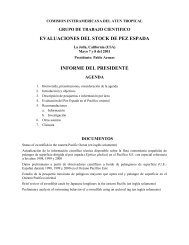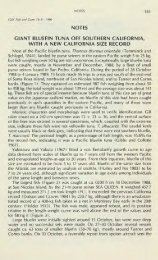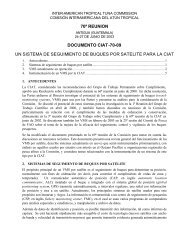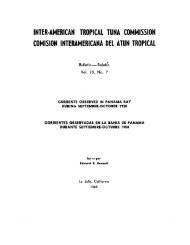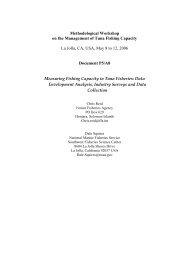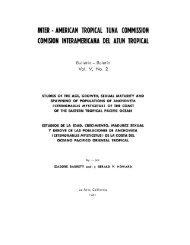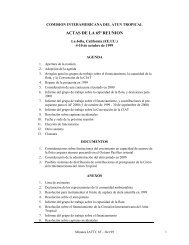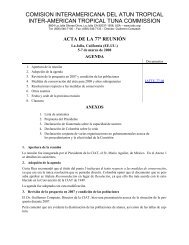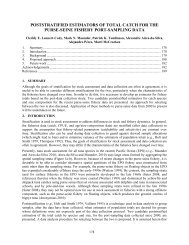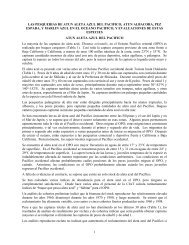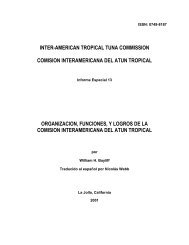Informe Anual de la Comisión Interamericana del Atún Tropical, 19
Informe Anual de la Comisión Interamericana del Atún Tropical, 19
Informe Anual de la Comisión Interamericana del Atún Tropical, 19
Create successful ePaper yourself
Turn your PDF publications into a flip-book with our unique Google optimized e-Paper software.
20 TUNA COMMISSION<br />
The edited raw data were transformed to logarithms and the individual measurements were<br />
adjusted to those expected for a mean TL of 639 mm by allometric formu<strong>la</strong>e in which the common<br />
within-groups allometric coefficients were used for each of the morphometric measurements. The<br />
transformed data were then subjected to a principal components analysis (PCA) operating on the<br />
total variance-covariance matrix. PCA is a multivariate technique useful for examining<br />
re<strong>la</strong>tionships among several variables such as linear measurements. The PCA successfully provi<strong>de</strong>d<br />
an overall view of the data. The calcu<strong>la</strong>ted eigenvalues indicate that the first two 01' three<br />
components provi<strong>de</strong> a good summary of the data. The first, first two, and first three components<br />
exp<strong>la</strong>in 58, 71, and 81 percent of the total sample variance, respectively. The first component is a<br />
measure of overall shape. The first eigenvector has high positive values for al] seven variables, and<br />
thus the first principal component appears to be essentially an average of these variables. However,<br />
SAF, SSD, and FDAF, in that or<strong>de</strong>r, appear to have the greatest discriminatory powers. (The<br />
measurements are <strong>de</strong>scribed in Table 13.) The second principal component appears to be acontrast of<br />
the SFD, SSD, and HL, and FDSD, FDAF, and SDAF. The interpretation of the third component is<br />
not obvious.<br />
Cluster analyses have been performed on the adjusted data to assign the fish to groups on a<br />
geographical basis as suggested by the data, rather than doing so on an a priori basis. Eleven<br />
different methods ofthe agglomerative hierarchical clustering procedure were applied to the data.<br />
The number of popu<strong>la</strong>tion clusters for each clustering method was assessed, using three criteria<br />
which have been found to perform best: a pseudo F statistic, a pseudo t2statistic, and the cubic<br />
clustering criteria. Since each of the clustering methods is biased to sorne extent (but in different<br />
ways), a consensus ofthe results ofthe 11 methods with respect to the number of clusters and the<br />
composition within clusters was utilized. In summary, seven of the clustering methods indicate two<br />
clusters, one indicates three, two indicate four, and one indicates five. There is sorne agreement ofthe<br />
composition ofthe c\usters at the two-cluster level, with a north-south dimensiono The cluster which<br />
forms the northern component contains mainly samples from north of18°N, and that which forms<br />
the southern component contains primarily samples from south of 18°N.<br />
Forward stepwise discriminant analyses were used to c<strong>la</strong>ssify individual fish into groups,<br />
employing the jackknife-validation procedure. The results from the cluster analyses indicating<br />
geographical groups were used as the grouping i<strong>de</strong>ntification variables in the discriminant analyses.<br />
A cross-validation procedure was employed in which the observations within a group can be<br />
randomly subdivi<strong>de</strong>d into two separate groups; then the c<strong>la</strong>ssification function is estimated from the<br />
first group, and the second group is c<strong>la</strong>ssified according to the function. The proportion of correct<br />
c1assification for fish from the second group provi<strong>de</strong>s an empirical measure of the success of the<br />
discrimination. The results ofthe stepwise discriminant analyses are given in Table 14. The percentcorrect<br />
c<strong>la</strong>ssification for the data without any subsampling for cross validation was a total of 76.7<br />
percent, with 72.0 percent for the northern group and 78.7 percent for the southern group. The<br />
discriminant function analysis revealed that six of the seven morphometric characters investigated<br />
contributed significantly to the multivariate discrimination between the northern and southern<br />
groups of fish. These were, in or<strong>de</strong>r of importance, SDAF, SFD, FDSD, SAF, FDAF, and HL. The F<br />
value computed from the Maha<strong>la</strong>nobis D2 statistic testing for equality of group means showed a<br />
significant difference between the no:rthern and southern groups (F0.05, [6, 2467) = 153.87, P



